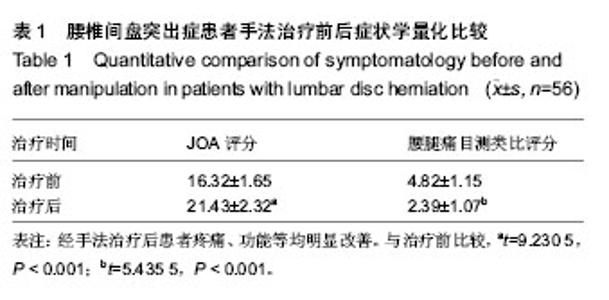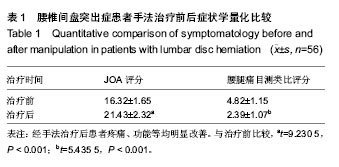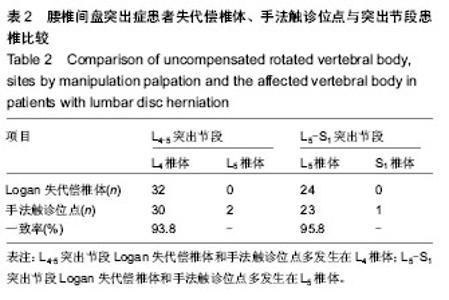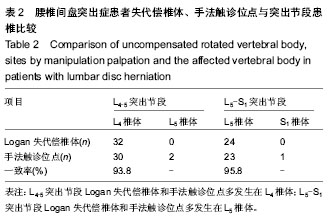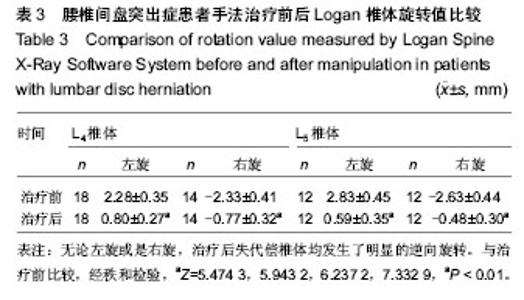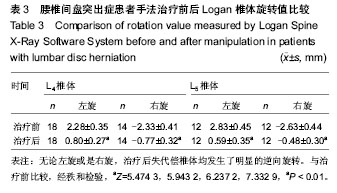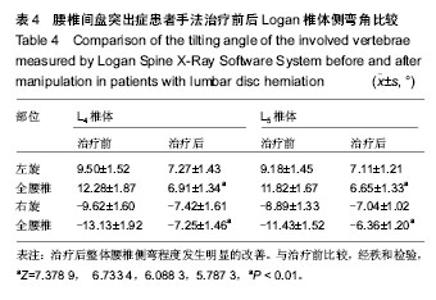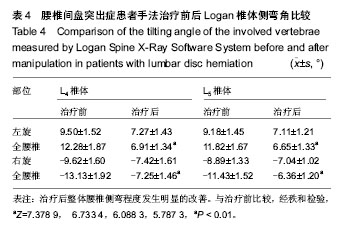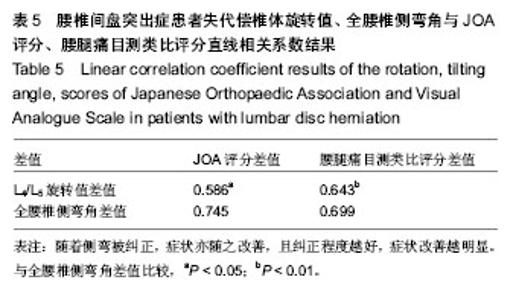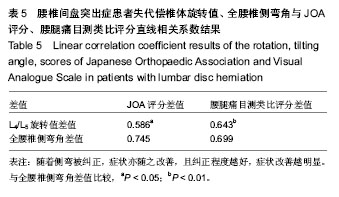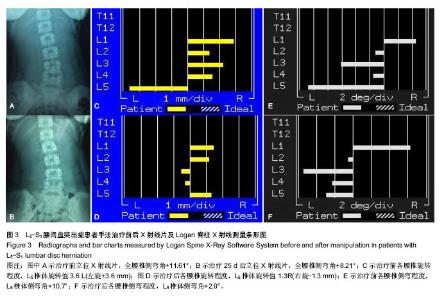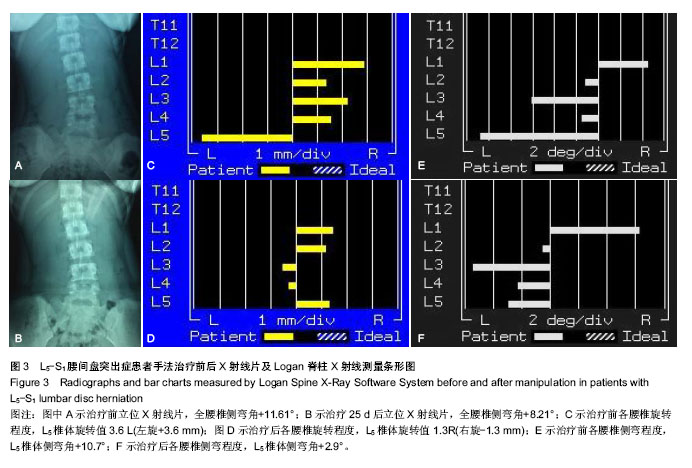| [1] 胡有谷.腰椎间盘突出症[M].4版.北京:人民卫生出版社,2011: 235.
[2] 赵平.下腰痛一般保守治疗方法的研究概况[J].中医正骨,1999, 11(3):44-46.
[3] 蒋位庄.脊源性腰腿痛[M].北京:人民卫生出版社,2002,220-222.
[4] 赵平.挺起健康的脊梁[M].北京:中国科学技术出版社,2011: 27-28.
[5] Gregory PG. Mobilisation of the spine.Churchil Livingstone 5th ed.1991;237-239.
[6] Birdwell KH. Selection of instrumentation and fusion levels for scoliosis: Where to start and where to stop.J Neurosurg Spine. 2004;(4):1-8.
[7] 冯伟,郭伟,邓晶晶,等.解读腰椎间盘突出症腰体形变化规律的研究[J].中国骨伤,2003,16(10):580-583.
[8] 励建安.脊柱运动的解剖和生物力学基础[J].中华物理医学与康复杂志,2004,26(5):308-310.
[9] 邹德威.脊柱退变与畸形[M].北京:人民卫生出版社,2008,135.
[10] 赵平,冯天有.椎体位移与腰椎间盘突出症27例临床研究[J].中国中医骨伤科杂志,1999,1(1):21-25.
[11] 高越,范宇,包春宇.新医正骨法纠正椎体旋转位移治疗31例青少年特发性脊柱侧凸的疗效观察[J].第四军医大学,2007,28(15): 1418-1420.
[12] 王文彪,郭学军,程远钊,等.旋转复位配合矫形鞋治疗退变性腰椎侧弯[J].中国骨伤,2007,20(4):265-266.
[13] 周小波,金涛,师瑞华,等.定位扳法与斜扳法治疗腰椎间盘突出症病例对照研究[J].中国骨伤,2008,21(12):895-898.
[14] 冯天有.中西医结合治疗软组织损伤的临床研究[M]. 北京:中国科学技术出版社,2002,33-35.
[15] 国家中医药管理局.中医病证诊断疗效标准[M].南京:南京大学出版社,1994:214.
[16] 井上骏一.腰痛治繚成绩判定基准[J].日整会志,1986,60: 391- 394.
[17] 中华医学会.临床诊疗指南疼痛学分册[M]. 北京:人民卫生出版社,2007:145.
[18] 王春强,宋文慧.脊柱侧凸影像学研究进展[J].国际骨科学杂志, 2013,34(2):84-87.
[19] He JW, Bai GH, Ye XJ, et al. A comparative study of axis-line-distance technique and Cobb method on assessing the curative effect on scolisis. Eur Spine J.2012;21(6): 1075-1081.
[20] Hong JY, Suh SW, Modi HN, et al. The prevalence and radiological findings in 1347 elderly patients with scoliosis. J Bone Joint Surg.2010;92(7):980-983.
[21] Barrios C, Lapuente JP, Sastre S. Treatment of chronic pain in adult scoliosis. Stud Health Technol.2002;88(8):290-303.
[22] 戴力扬.腰椎关节突关节的临床解剖[J].中国临床解剖学杂志, 1991,9(3):179-182.
[23] 高飞,赵斌.腰椎关节突关节基础研究新进展[J].医学影像学杂志, 2009,19(7):925-927.
[24] 马剑雄,马信龙,骆巍,等.后部结构对腰椎前屈后伸稳定性的影响[J].中国中西医结合外科杂志,2009,15(1):71-75.
[25] 马剑雄,马信龙,骆巍,等.后部结构对腰椎扭转稳定性的实验研究[J].天津医科大学学报,2008,14(2):177-179.
[26] 肖进,原林,赵卫东,等.侧弯和旋转运动对腰椎小关节承载功能的影响[J].第一军医大学学报,2003,23(2):148-150.
[27] 苏再发,张爱平,陈日齐.应用三维有限元法分析腰椎小关节的力学分布[J].中国组织工程研究与临床康复,2007,11(9): 1671-1674.
[28] 韩磊,赵平.青少年峡部裂性腰椎滑脱症及冯氏脊柱手法治疗[J].中国社区医师,2013,15(12):45.
[29] 冯宇,杨殊杰,高燕.手法治疗腰椎间盘突出症疗效以及解除神经根受压的MRM分析[J].中国骨伤,2005,18(8):456-458.
[30] 郭伟,赵平,周卫,等.腰椎间盘突出症手法治疗前后症状学评分与MRI 指标相关性研究[J].中国骨伤,2010,23(1):17-20.
[31] 冯伟,冯天有,王书勤.脊柱(定点)旋转复位法治疗巨大腰椎间盘突出症[J].中国骨伤,2007,20(11):749-751.
[32] 冯伟,冯天有,王飞,等.等脊柱定点旋转复位法治疗游离型腰椎间盘突出症[J].中国骨伤,2008,21(7):529-531.
[33] 赵平.腰椎管内突出椎间盘组织结构力学意义的探讨[J].航空军医,1995,23(4):244.
[34] 赵平,陈立君,管晶,等.腰椎间盘突出症患者手法治疗前后腰椎节段运动改变特点[J].中国中西医结合杂志,2001,21(3):186-189.
[35] 陈更新,于柏龙,杜劲松,等.腰椎生物代偿性变化生物力学机理的实验研究[J].中国急救医学,1999,19(4):205-208.
[36] 赵平,冯天有.椎体位移与腰椎间盘突出症[J].中国中医骨伤科杂志,1993,1(1):21-24.
[37] 齐伟,王朝晖.试论椎体移位的分型[J].中国社区医师,2007,9(18): 6.
[38] 赵平,田青.脊柱手法治疗腰椎间盘突出症原则的演变[J].中国骨伤,2009,22(4):276-278.
[39] 冯天有,赵平,梁国跃,等.腰椎管内突出髓核的临床意义探讨[J].中国中西医结合杂志,2000,20(5):347-349.
[40] 陈博,詹红生,石印玉,等.骨错缝、筋出槽病机学说及其动物模型的建立[J].上海中医药大学学报,2010,24(5):68-72.
[41] 詹红生,石印玉,张明才,等.基于“骨错缝、筋出槽”病机认识的椎间盘病症诊治新观点[J].上海中医药杂志,2007,41(9):4-6.
[42] 房敏,朱清广,洪水棕.推拿手法调整脊柱骨错缝的杠杆原理分析[J].中国骨伤,2010,23(10):780-783.
[43] 胡华,熊昌源,韩国武.模拟腰部推拿手法建立腰-盆-髋有限元模型[J].中国组织工程研究与临床康复,2011,15(48):8935-8938.
[44] 王华峰,沈建雄.矢状位脊柱与骨盆排列关系的研究进展[J].中国骨与关节外科,2009,2(3):246-248.
[45] 马迅,郭建鹏,梁凯恒,等.脊柱颈胸结合部(C6-T1)三维有限元模型的建立及有限元分析[J].中国骨伤,2010,23(1):5-8. |
